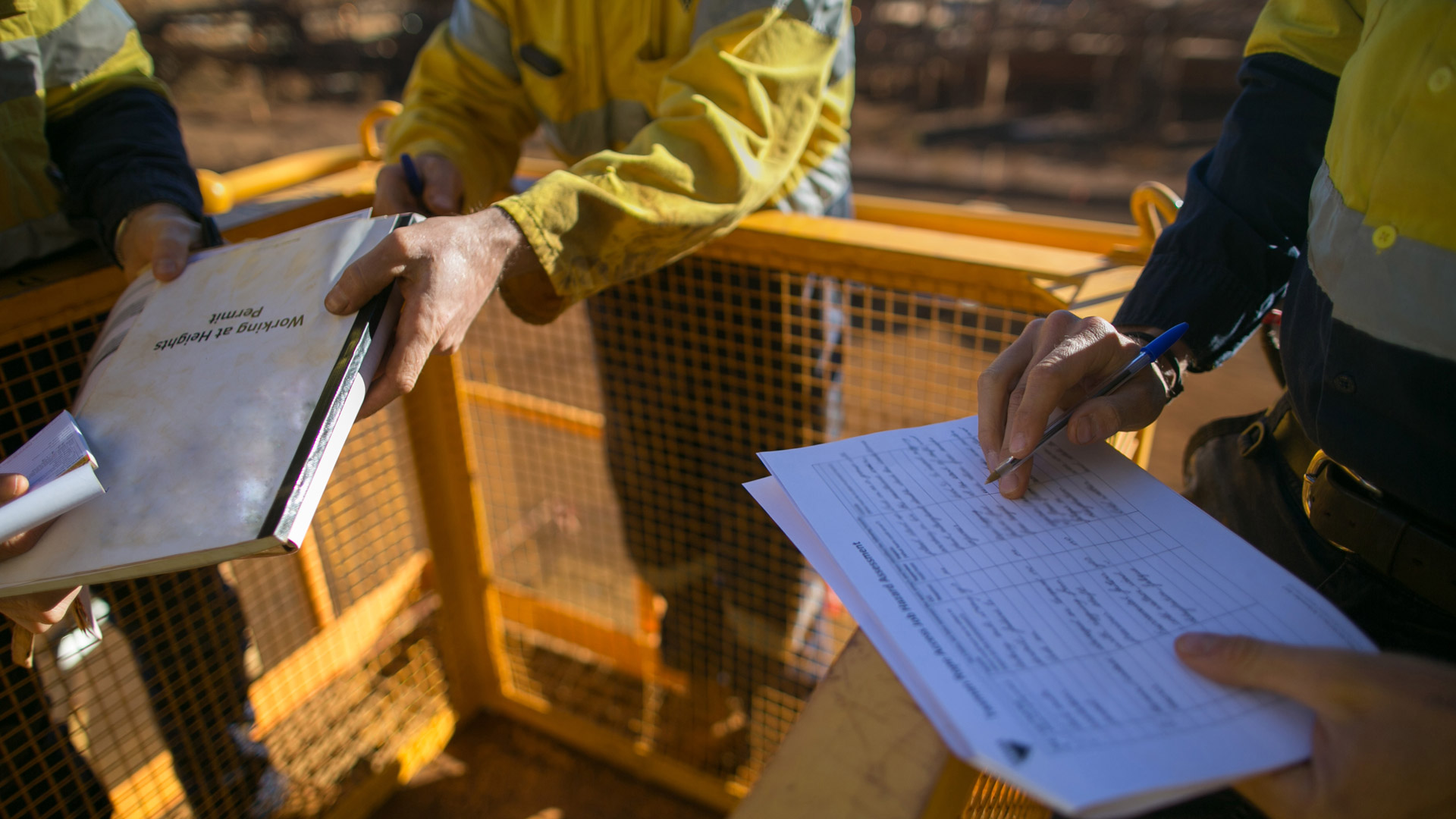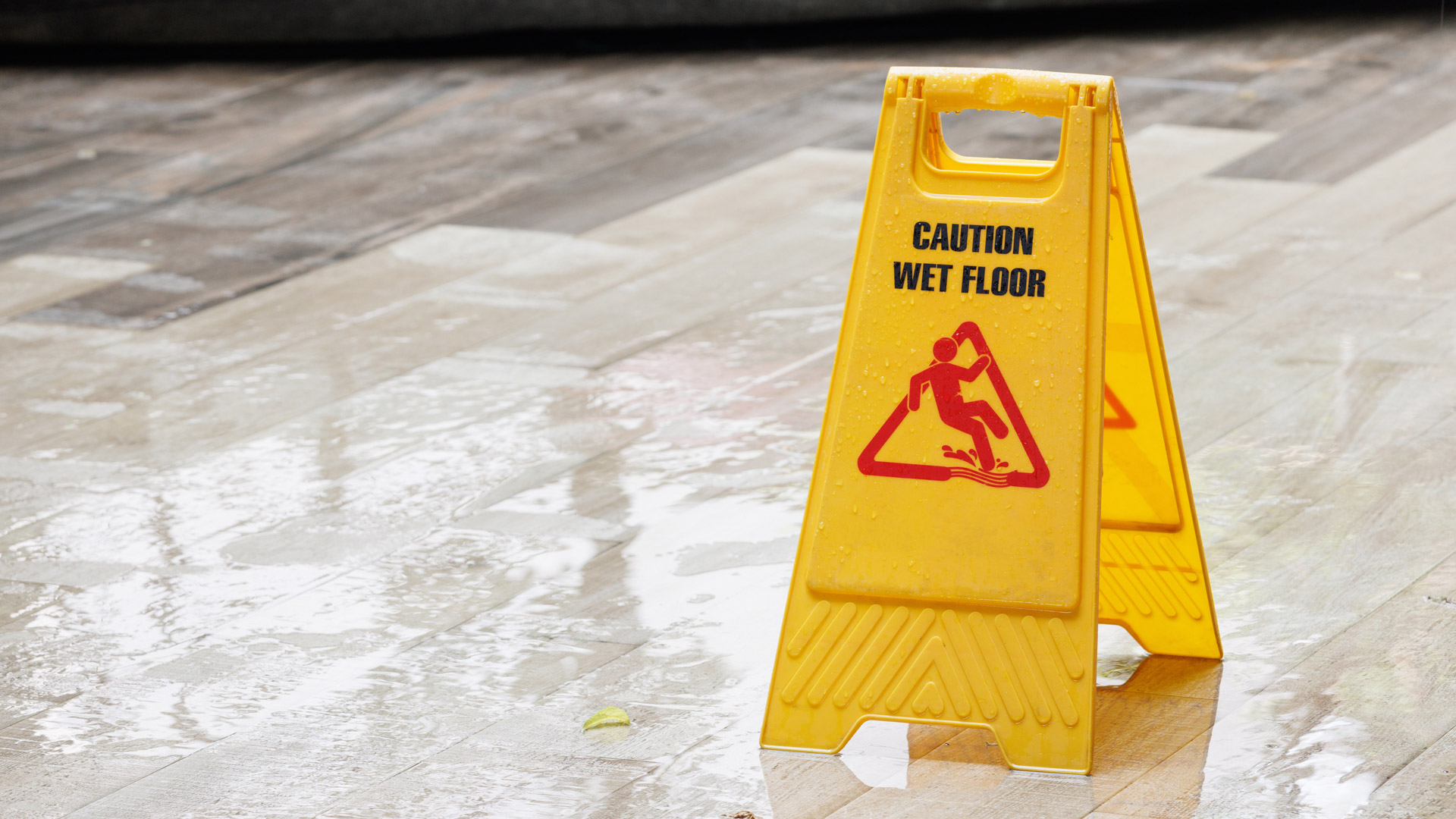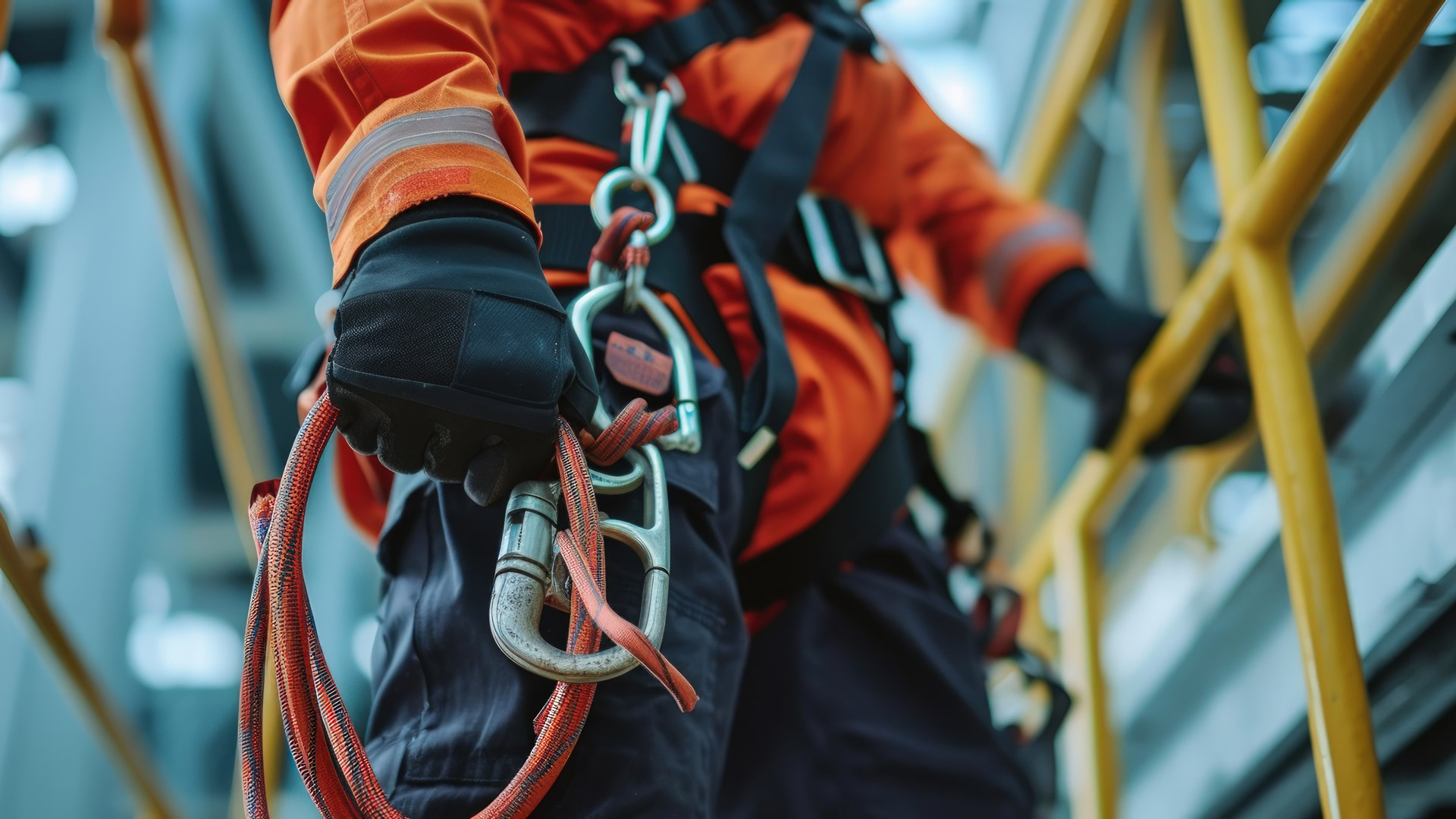RISK
GUIDE
The dangers of working at height: a manager’s guide

Published by Kate Gardner,
11 Apr 2023
INTRODUCTION
Working at height remains one of the biggest causes of fatalities and major injuries. Common cases include falls from ladders and through fragile surfaces.
The Work at Height Regulations 2005 apply to all work where there might be a risk of a fall liable to cause personal injury. Since the introduction of the regulations, the UK has consistently had some of the lowest workplace fatality and serious injury rates in the European Union. However, data from the HSE finds that 18% of those who died at work did so as a result of a fall from height. For those who experience non-fatal accidents, a fall can lead to life-changing injuries and affect not just the victim but also their family, friends and colleagues.
There is a requirement to undertake a suitable and sufficient risk assessment on all work where there is a risk of injury as a result of a fall from height.
In his independent report, Reclaiming health and safety for all: an independent review of health and safety legislation, Professor Ragnar E Löfstedt noted that only “a small number of managers were able to correctly define working at height and very few actually understood the regulatory requirements”. Alongside technical and regulatory training provided to managers, the report also raised concerns about the lack of training in ‘soft skills’, such as how to communicate effectively. This leads to poor supervision of workers and inevitably creates environments where a fall from height is more likely to occur.
This guide aims to look at the definition of working at height and how managers can more effectively control it.

WHAT IS WORK AT HEIGHT?
'Work at height' means work in any place where, if no precautions were in place, a person could fall a distance liable to cause personal injury (for example, a fall through a fragile roof).
The regulations define ‘at height’ as a place at which a person could be injured falling from, even if it is at or below ground level.
You are working at height if you:
- Work above ground/floor level;
- Could fall from an edge, through an opening or fragile surface; or
- Could fall from ground level into an opening in a floor or a hole in the ground.
Working at height can also (but not always) include work below ground such as in basements and cellars.
Working at height does not include:
- Working up and down the staircase in an office.
- Working in the upper floors of an office block or a Portakabin.
- An operator sitting in a seat on an excavator.
- Sitting in a chair.
Work at height also does not include a slip or a trip on the level, as a fall from height has to involve a fall from one level to a lower level, nor does it include walking up and down a permanent staircase in a building.
The key point is that workers don’t need to fall far to be seriously injured or even killed.

COMMON CAUSES OF WORK AT HEIGHT ACCIDENTS
Roof work
Roof work is high risk and falls from roofs, through fragile roofs and fragile roof lights are the most common causes of workplace death and serious injury. As well as in construction, these accidents also occur on roofs of factories, warehouses and farm buildings when roof repair work or cleaning is being carried out.
The following are likely to be fragile:
- Roof lights.
- Liner panels on built-up sheeted roofs.
- Non-reinforced fibre cement sheets.
- Corroded metal sheets.
- Glass (including wired glass).
- Rotted chipboard.
- Slates and tiles.
Ladders and stepladders
Contrary to popular belief, ladders and stepladders are not banned under health and safety law. The law calls for a sensible, proportionate approach to managing risk, and ladders can be a sensible and practical option for low-risk, short-duration tasks, although they should not automatically be your first choice.
There are simple, sensible precautions you should take to stay safe when using portable leaning ladders and stepladders in the workplace.
Make sure that you use the right type of ladder and that you know how to use it safely.
As a guide, only use a ladder:
- On firm ground.
- On level ground.
- On clean, solid surfaces (paving slabs, floors etc.).
- Where it will not be struck by vehicles (protect the area using suitable barriers or cones).
- Where it will not be pushed over by other hazards such as doors or windows.
- Where the general public are prevented from using it, walking underneath it or being at risk because they are too near.
- Where it has been secured.
Falling equipment
Another risk of working at height is equipment falling from height. You may think that the impact of dropped items is less severe, but this too can be fatal. Any number of injuries, from fractures to paralysis and death, can be caused by dropping items from relatively low heights.
More often than not, the ground level area below work taking place at height is cordoned off and access is restricted. Workers below are required to wear personal protective equipment (PPE), including hard hats, which protect against dropped items.
Where it is necessary to prevent injury, you must do all that is reasonably practicable to prevent anything falling. If it is not reasonably practicable, you must ensure that no one is injured by anything falling.
You must ensure that nothing is:
- Thrown or tipped from height if it is likely to injure anyone; or
- Stored in such a way that its movement is likely to injure anyone.
If the workplace contains an area in which there is a risk or someone being struck by a falling object or person, you must ensure that the area is clearly indicated and that (as far as is reasonably practicable) unauthorised people are unable to reach it.
WHAT THE LAW SAYS
The purpose of the Work at Height Regulations 2005 is to prevent death and injury caused by a fall from height. If you are an employer or you control work at height (for example, facilities managers or building owners who may contract others to work at height) the Regulations apply to you.
Employers and those in control of any work at height activity must make sure work is properly planned, supervised and carried out by competent people. This includes using the right type of equipment for working at height.
Employers and those in control must first assess the risks.
Employees have general legal duties (under the Health and Safety at Work etc. Act 1974) to take reasonable care of themselves and others who may be affected by their actions, and to cooperate with their employer to enable their health and safety duties and requirements to be complied with.
In addition, as part of the Work at Height Regulations, you must ensure:
- All work at height is properly planned and organised;
- Those involved in work at height are competent;
- The risks from work at height are assessed, and appropriate work equipment is selected and used;
- The risks of working on or near fragile surfaces are properly managed; and
- The equipment used for work at height is properly inspected and maintained.

WHO IS RESPONSIBLE?
The Regulations place duties on employers, the self-employed, and any person who may contract individuals to work at height, including building owners, facilities managers or householders. As of 2014, over a million UK businesses and ten million workers were estimated to carry out work involving some form of work at height every year.
Employers, facilities managers, building owners and anyone else who controls work at height, including the self-employed, can be held responsible should an accident occur. They would be liable if an accident occurred and equipment was found to be faulty or uncertified.
These individuals and organisations have a legal responsibility to ensure that the Work at Height Regulations 2005 are implemented and that all activity is properly planned, supervised and carried out by competent persons.
The employer (or organisation that controls work at height, such as a facilities management company) is required to take responsibility for certain duties of care under the Work at Height Regulations 2005. The Regulations state that the employer must ensure that workers have available to them the appropriate work at height equipment, including Personal Protective Equipment (PPE). Workers should also receive appropriate training in the use of that equipment and whilst they are in training with the equipment, they should be properly supervised.
Case study
A Northallerton-based heating centre was fined nearly £200,000 for failings that led to the death of one of its employees. Twenty-four-year-old Luke Crocher was working on the roof of a house when he fell 30 feet onto a patio, suffering serious head injuries. He was rushed to hospital but died later the same day.
His employer, Northallerton Heating Centre, admitted to corporate manslaughter charges through its managing director, Mark Anthony Flintof. Leeds Crown Court heard Mr Crocher’s employer failed to ensure that suitable and sufficient measures were in place to prevent him falling and had failed to ensure that the work was properly planned, supervised and carried out safely.
Mr Crocher had not had the proper safety training and was not being properly supervised.
RISK ASSESSMENT
As with any work activity, it is vital to conduct a thorough risk assessment to identify all potential hazards associated with working at height. A risk assessment should be conducted at least annually and organisations with more than five employees are required to record any significant findings.
Your risk assessment should cover all the risks faced by each different type of employee. For example, construction workers may complete work on a fragile roof where they are at risk of the surface collapsing, whereas a surveyor may use a ladder to inspect roofing, where they are at risk of the ladder being unstable.
When preparing your risk assessment, you must ensure:
- That no work is carried out at height if it is safe and reasonably practicable to do it other than at height.
- That it is properly planned, appropriately supervised and carried out in as safe a way as is reasonably practicable.
- That you plan for emergencies and rescue.
- That you act upon its findings.
Factors to take into account when assessing the risks include:
- The work activity itself.
- The equipment to be used.
- The duration of the work.
- The location where the work activity is to take place – including the presence of hazards such as overhead powerlines and open excavations.
- The working environment – e.g., weather conditions and lighting.
- The condition and stability of existing work surfaces.
- The knowledge, experience and physical capabilities of the personnel involved.

HAZARDS
IOSH highlights two groups of hazards to be identified in a risk assessment – personal hazards and physical hazards.
Physical hazards
The main hazards are either workers or objects falling from height. Identifying these hazards is key to correctly assessing the risks of working at height. There are many causes of these hazards, including:
- Unsafe, faulty or poor design of access equipment, including harnesses and lanyards.
- Unprotected edges of roofs and services, including fragile roofs, unprotected openings and excavations.
- Siting of access equipment – for example, unstable surfaces and covers of sewer access points not able to support the weight of access equipment.
- Weather conditions that relate to hazards, such as lightning (to which people working at height can be more exposed), or that contribute to a person or objects falling from height.
- Thermal effects – for example, embrittlement of metal ladders in very cold weather.
- Unintended use of access equipment.
- Carrying or moving heavy loads at height. Interaction with other machinery.
- Poor planning and organising of work at height activities.
- Not providing a safe system of work and ensuring it is followed.
Personal hazards
These include:
- Workers’ attitudes and behaviours.
- Medical conditions and disabilities.
- Young workers.
- Lone workers.
- Workers with insufficient or inadequate information, training, instruction or supervision.

COMPETENCE
Regulation 5 of the Work at Height Regulations 2005 requires that every employer should ensure that no person engages in any activity, including organisation, planning and supervision, in relation to work at height or use equipment for such work, unless they are competent to do so or, if being trained, is being supervised by a competent person.
You should make sure that people with sufficient skills, knowledge and experience are employed to perform the task.
In the case of low-risk, short duration tasks involving ladders, competence requirements may be no more than making sure employees receive instruction on how to use the equipment safely (e.g., how to tie a ladder properly) and appropriate training. Training often takes place on the job; it does not always take place in a classroom.
When a more technical level of competence is required, for example drawing up a plan for assembling a complex scaffold, existing training and certification schemes drawn up by trade associations and industry can help demonstrate competence.

TRAINING
For employees to work safely at height they must be properly trained and educated on the risks they will face and best practices to overcome these.
Once initial certification is achieved, refresher training should be conducted within the recommended timeframes, although shorter, more frequent, training can be beneficial in ensuring safe practices are consistently followed.
When employees regularly complete the same tasks there is the risk that they may go into ‘auto-pilot’ mode. This can result in complacency as employees become desensitised to the dangers they face and therefore make more risky decisions.
To reduce complacency, employees should frequently be reminded of the risks faced by their routine tasks.
Competence in the workplace begins with thorough and consistent training that is not only proven and to recognised industry standards but is intrinsic to a working career. There are still many who trained ‘on the job’ for their trade in their 20s and have never received any formal training since.
International Workplace's Working at height course helps learners understand the dangers associated with working at height and implement ways to minimise and control the risks. The course is designed for employees and operatives who are required to work at height.

CONCLUSION
The Work at Height Regulations 2005 have been crucial in raising health and safety standards across all sectors that undertake work at height. However, compliance and enforcement of the regulations have not sufficiently changed behaviour to ensure workers avoid fatalities and serious accidents. The majority of responses to the 2018 All-Party Parliamentary Group enquiry into working at height noted that culture plays a crucial role in whether a fall will occur. The stronger the safety culture within a company, the safer the place of work and the less likely it is that workers will experience a fall from height.
Working at height is a risky business. Risks need to be properly assessed and work carefully planned, even at relatively low heights. Regulation is an important driver for raising standards but compliance alone is not enough. A mature safety culture instils positive safety behaviour while tailor-made product solutions can provide another invaluable line of defence.
Commenting on the Revocation and Reform Bill, which is currently being passed through Parliament, the Scaffolding Association says:
“The Bill includes over 2,400 laws and regulations which are being considered following the UK’s exit from the European Union. Between now and the end of 2023, government ministers can decide which ones to keep, amend or scrap completely. Included within the Bill are the Working at Height Regulations (WAHR). Since their introduction, there is no doubt that they have helped to improve safety and reduce fatalities within the workplace.
“Statistics published annually by the HSE consistently demonstrate that working at height remains the single largest contributing factor to workplace fatalities and that almost a quarter of all workplace fatalities occur because of falls from height.”

KEY TAKEAWAYS
-
'Work at height' means work in any place where, if no precautions are in place, a person could fall a distance liable to cause personal injury.
-
Prior to the introduction of the Work at height Regulations (2004), there were 67 workplace fatalities as a result of falls from height. This number has fallen to 29 in 2021/22.
-
Data from the HSE finds that 18% of those who died at work did so as a result of a fall from height.
Contrary to popular belief, ladders and stepladders are not banned under health and safety law. -
Any number of injuries, from fractures to paralysis and death, can be caused by dropping items from relatively low heights.
-
Regulation 5 of the Work at Height Regulations 2005 requires that every employer should ensure that no person engages in any activity in relation to work at height or use equipment for such work, unless they are competent to do so.
-
To reduce complacency, employees should frequently be reminded of the risks faced by their routine tasks.
SOURCES:
You might also be interested in
RELATED CONTENT
RELATED COURSES

The Accident and incident reporting course helps learners develop skills to deal with the aftermath of an accident or incident.

IOSH Working Safely is a one-day introductory health and safety training course for people at any level, in any sector.

The Slips, trips and falls course explains the measures that can be implemented to prevent slips, trips and falls in the workplace.

The Working at height course helps learners understand the dangers associated with working at height and ways to control the risks

Work at height continues to be the most common cause of fatal injury, according to the HSE’s latest statistics, published on 6 July.

Solar panel company Blue Sun Energy Limited has been sentenced for safety breaches after a self-employed labourer fell through a rooflight.

The Access Industry Forum (AIF), the forum that represents the principal work at height trade associations and federations, is calling for clearer rep...

A Northallerton-based heating centre has been fined nearly £200,000 for failings that led to the death of one of its employees.